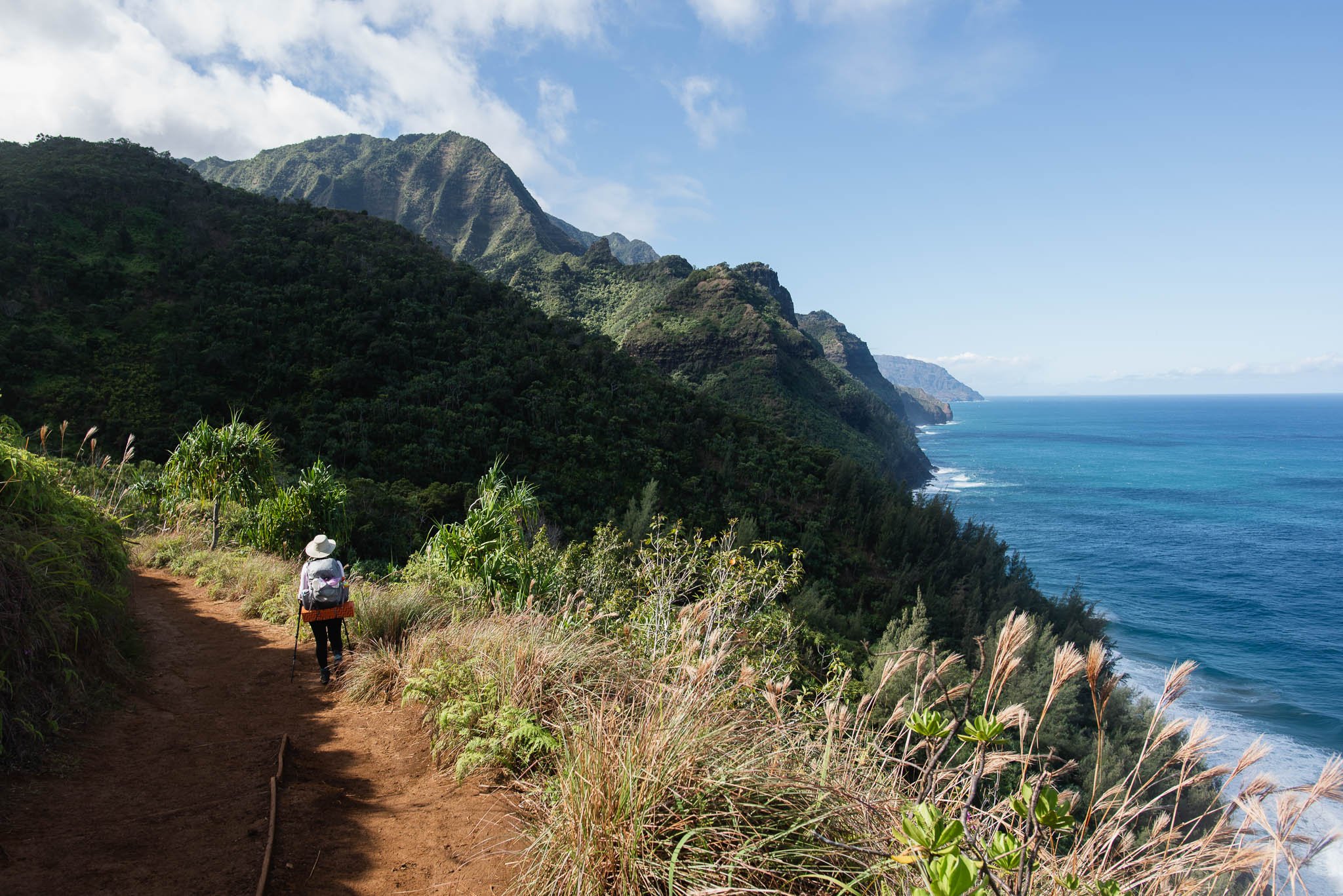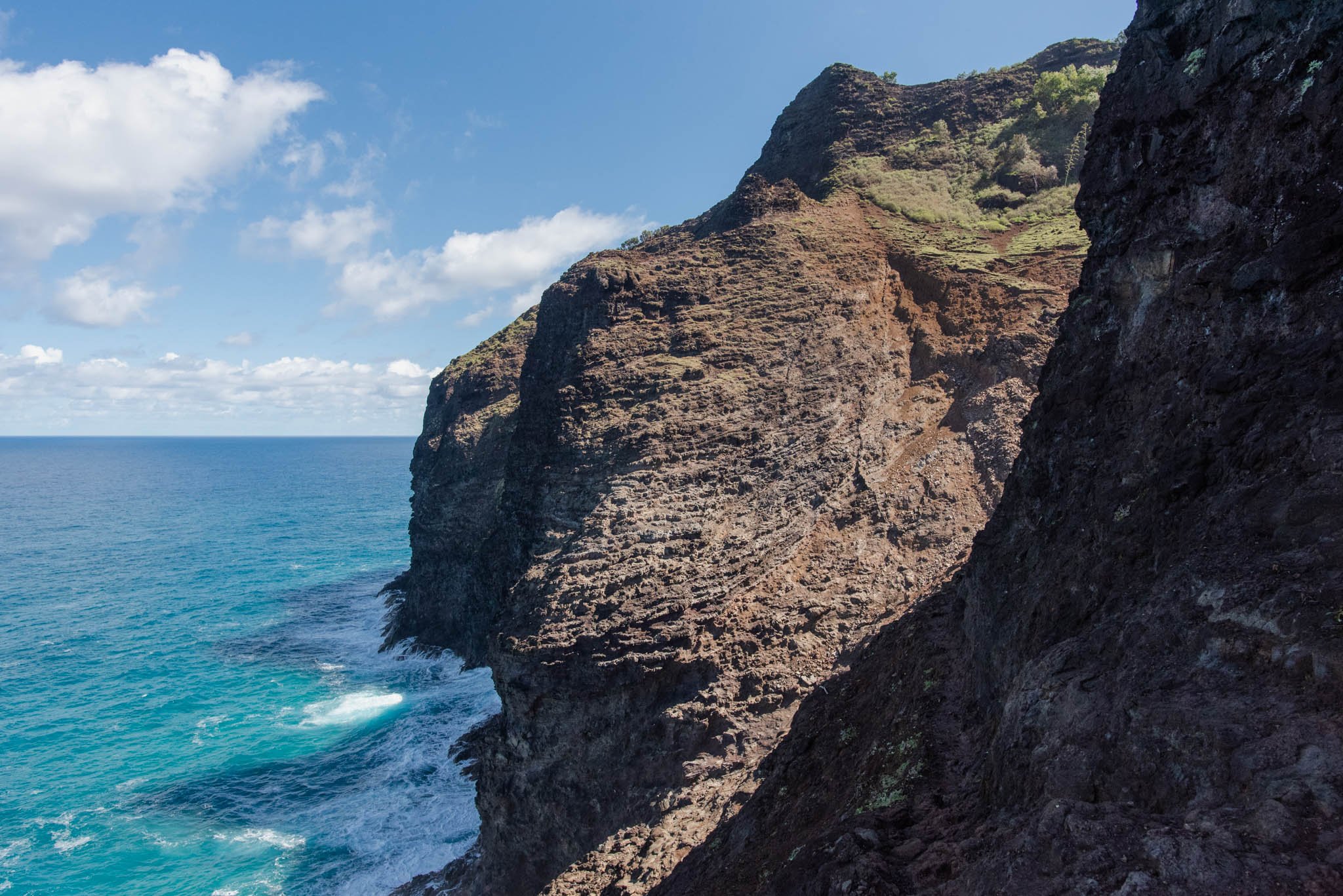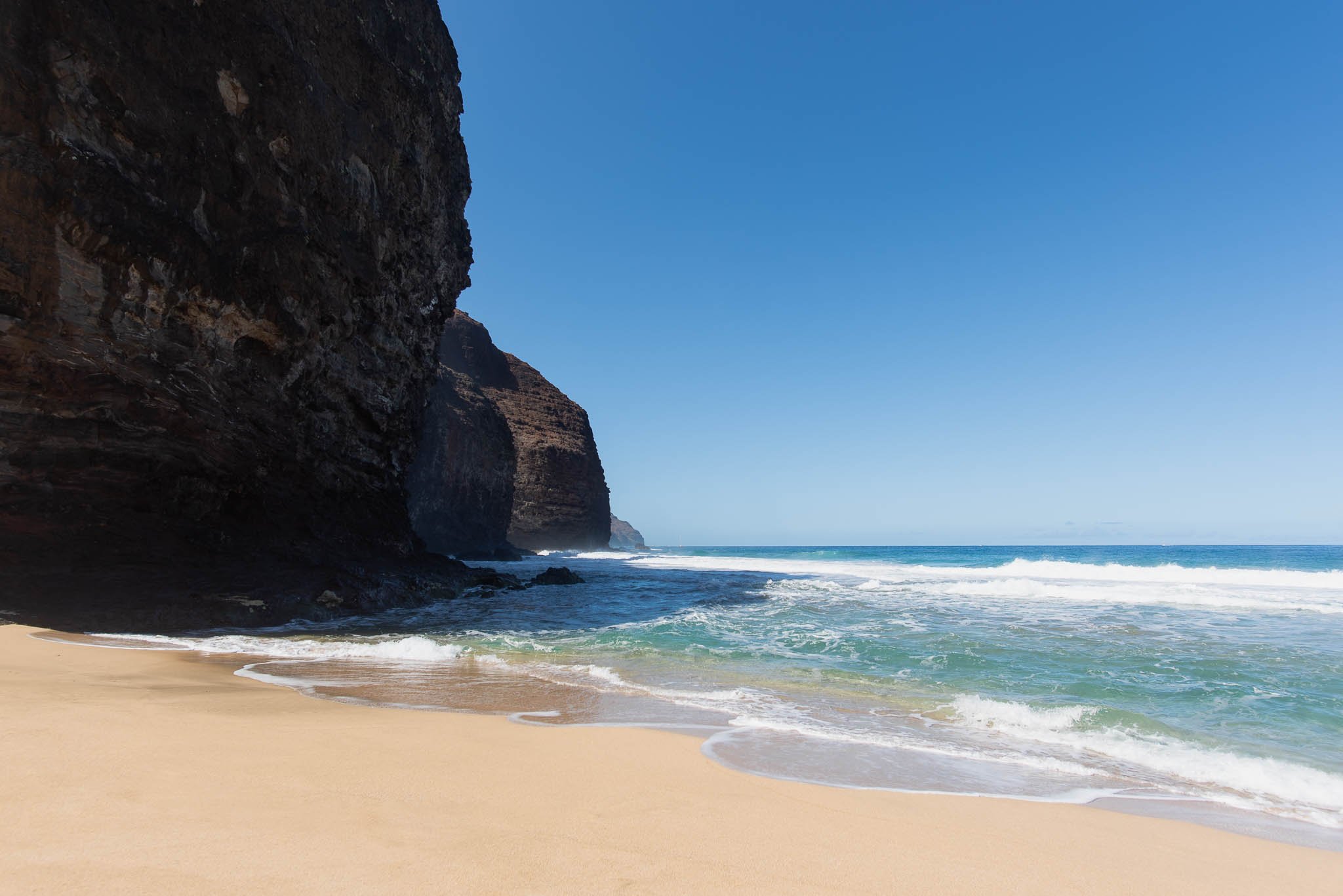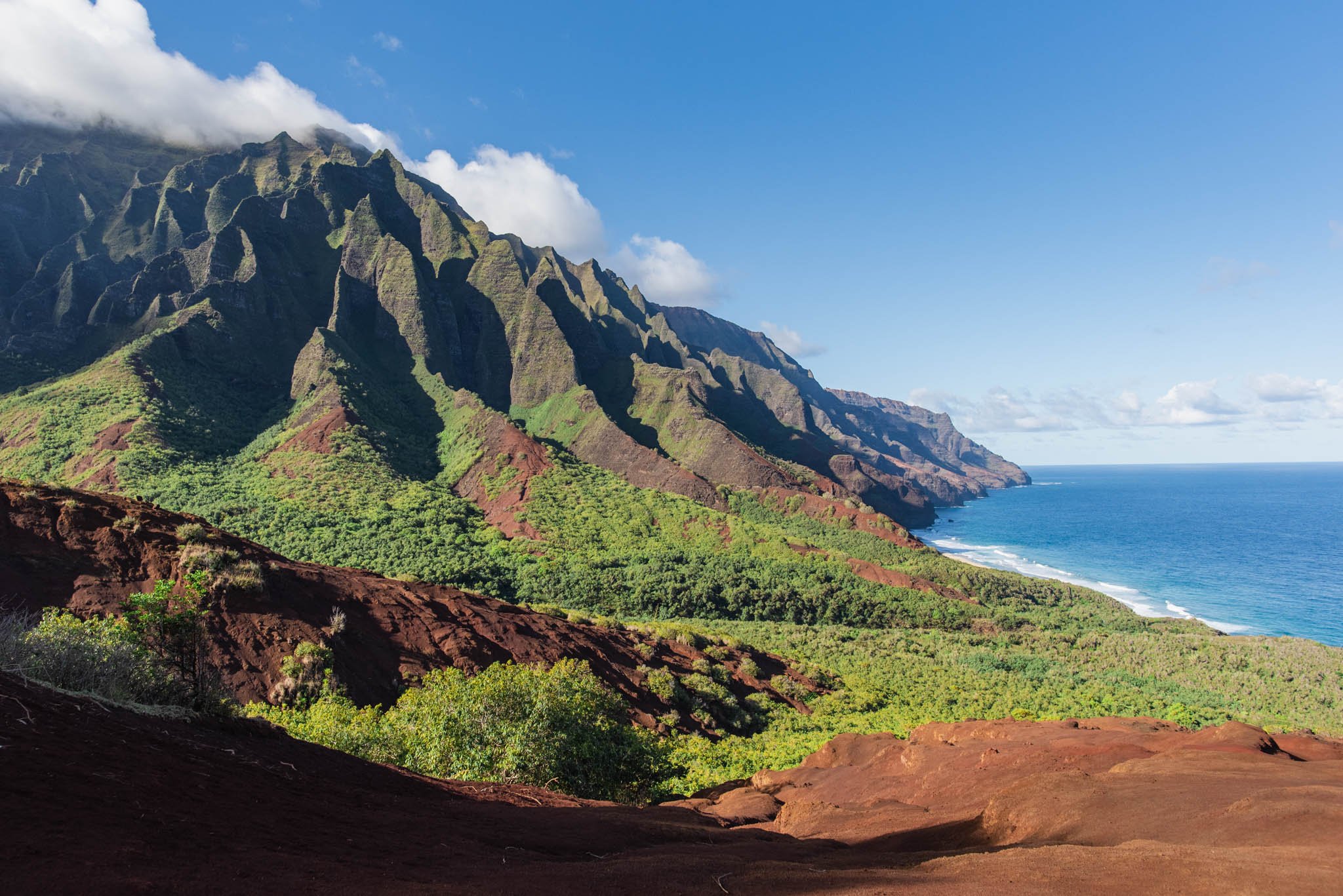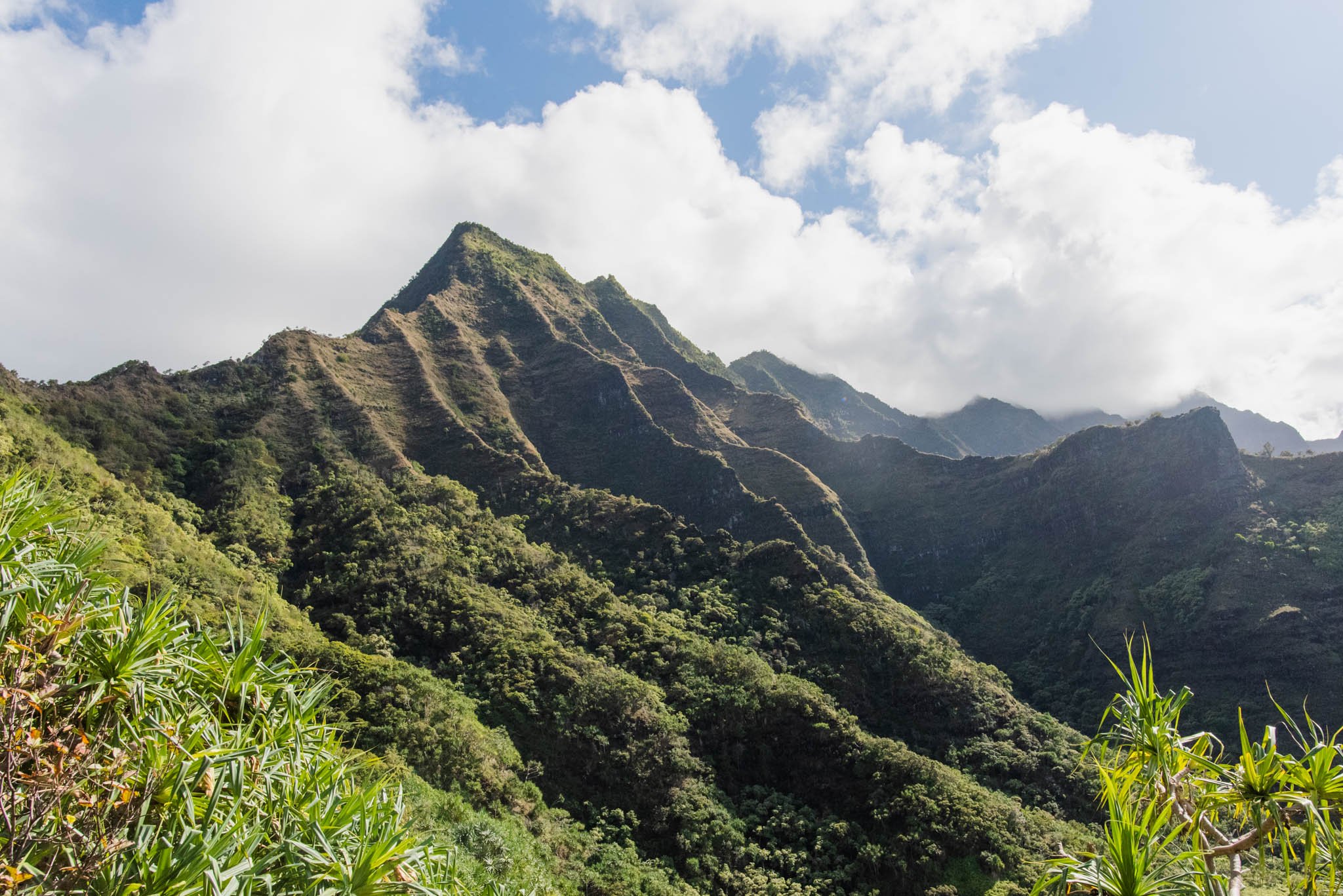Kalalau Trail: Backpacking the Nāpali Coast of Kauai
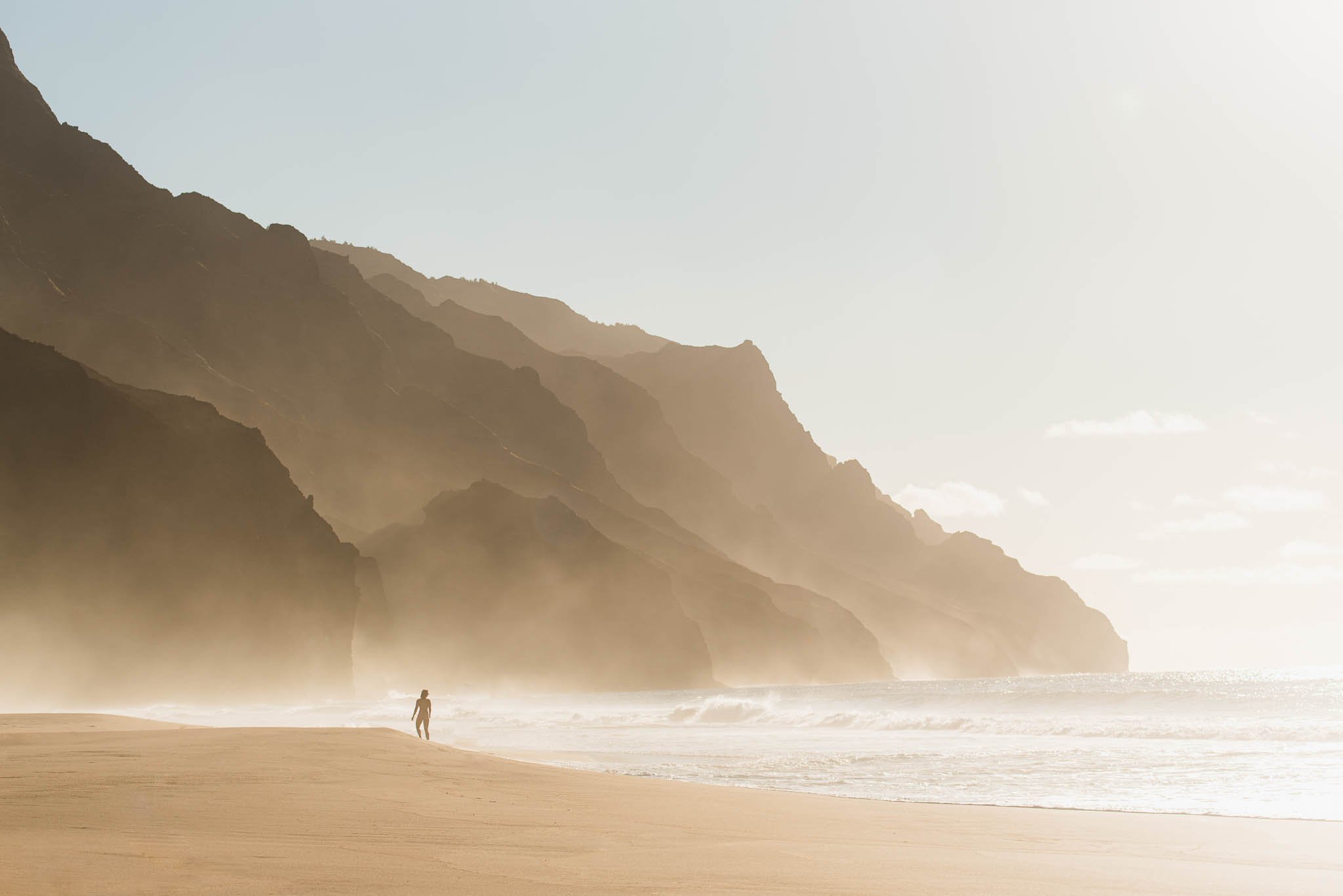
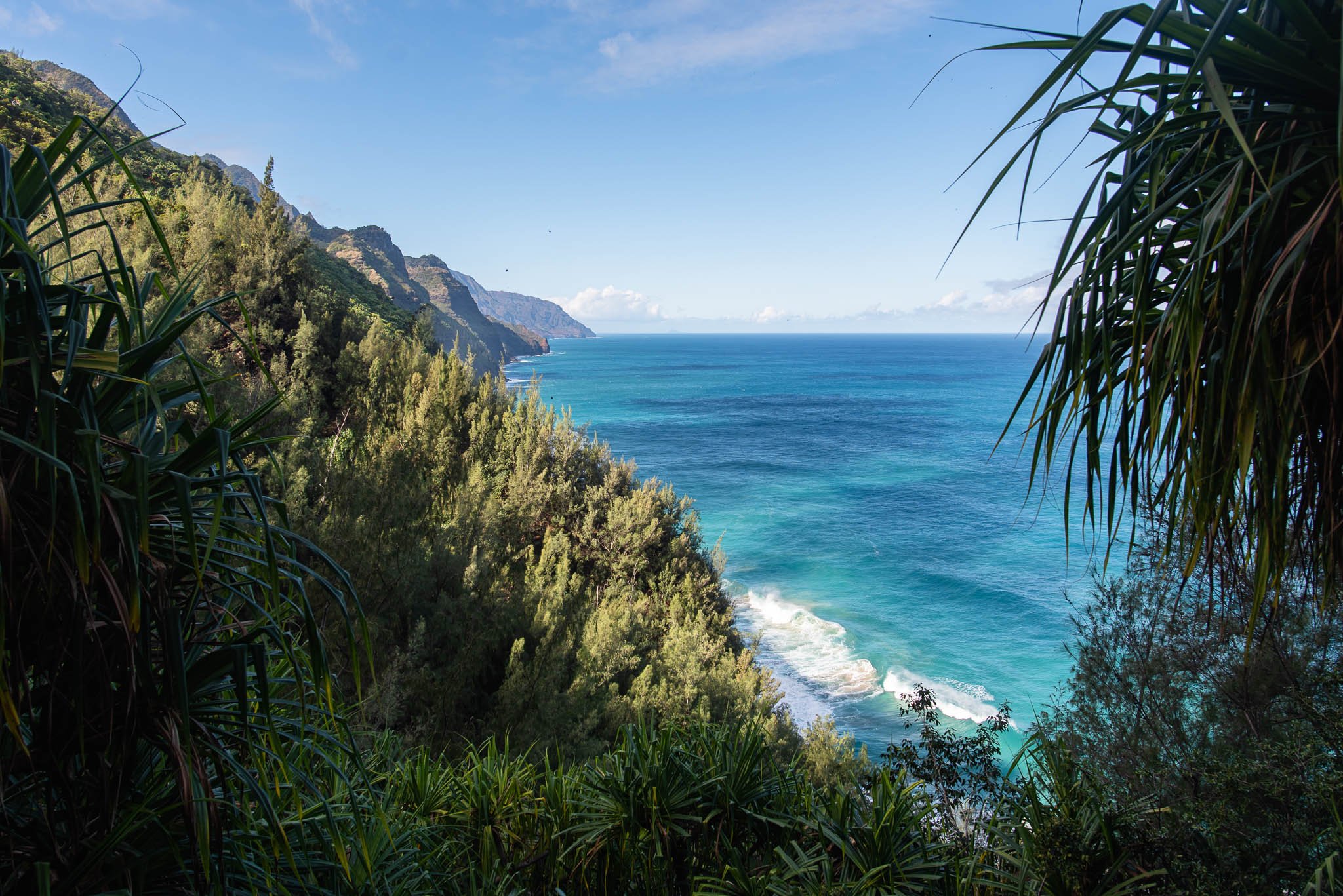

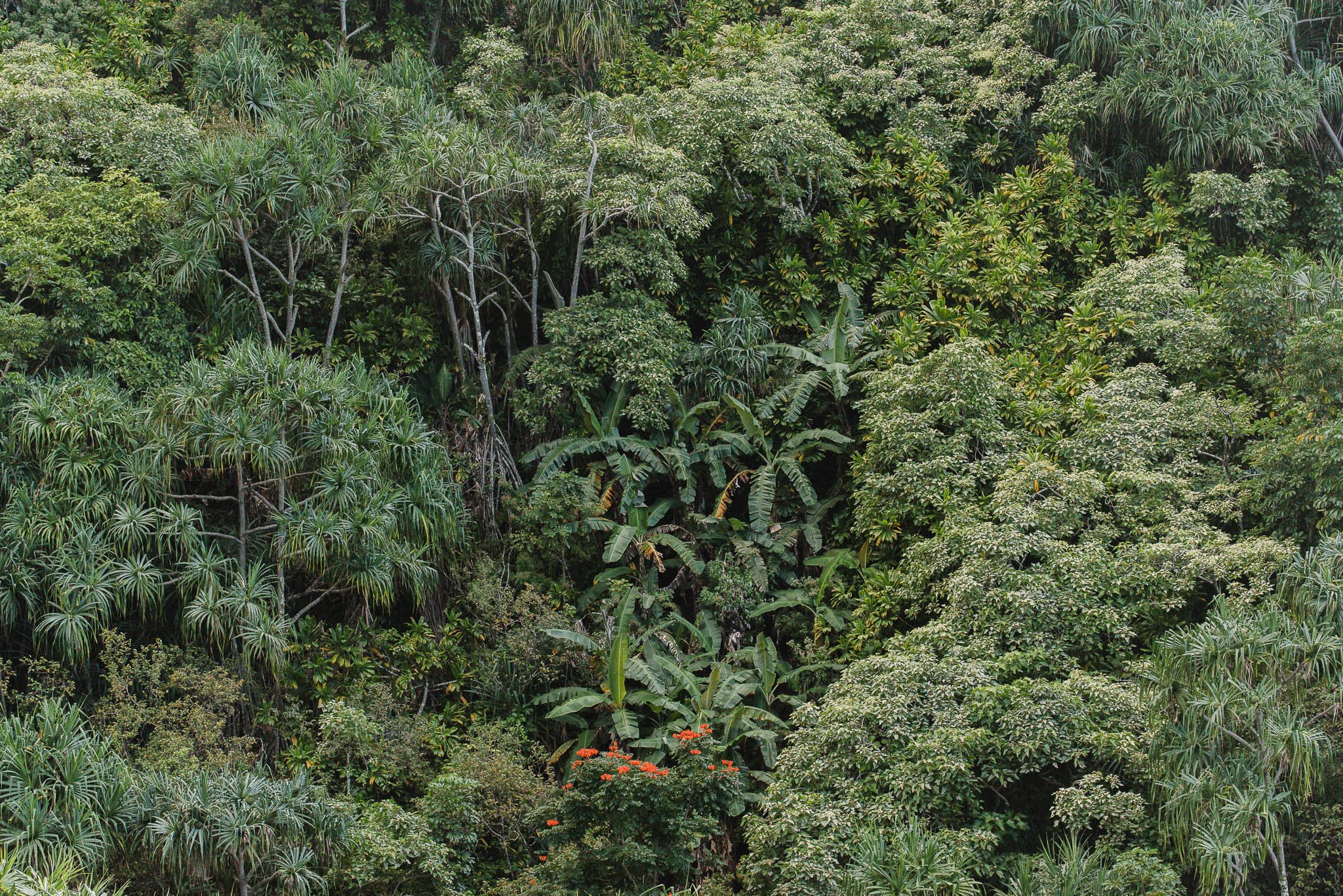

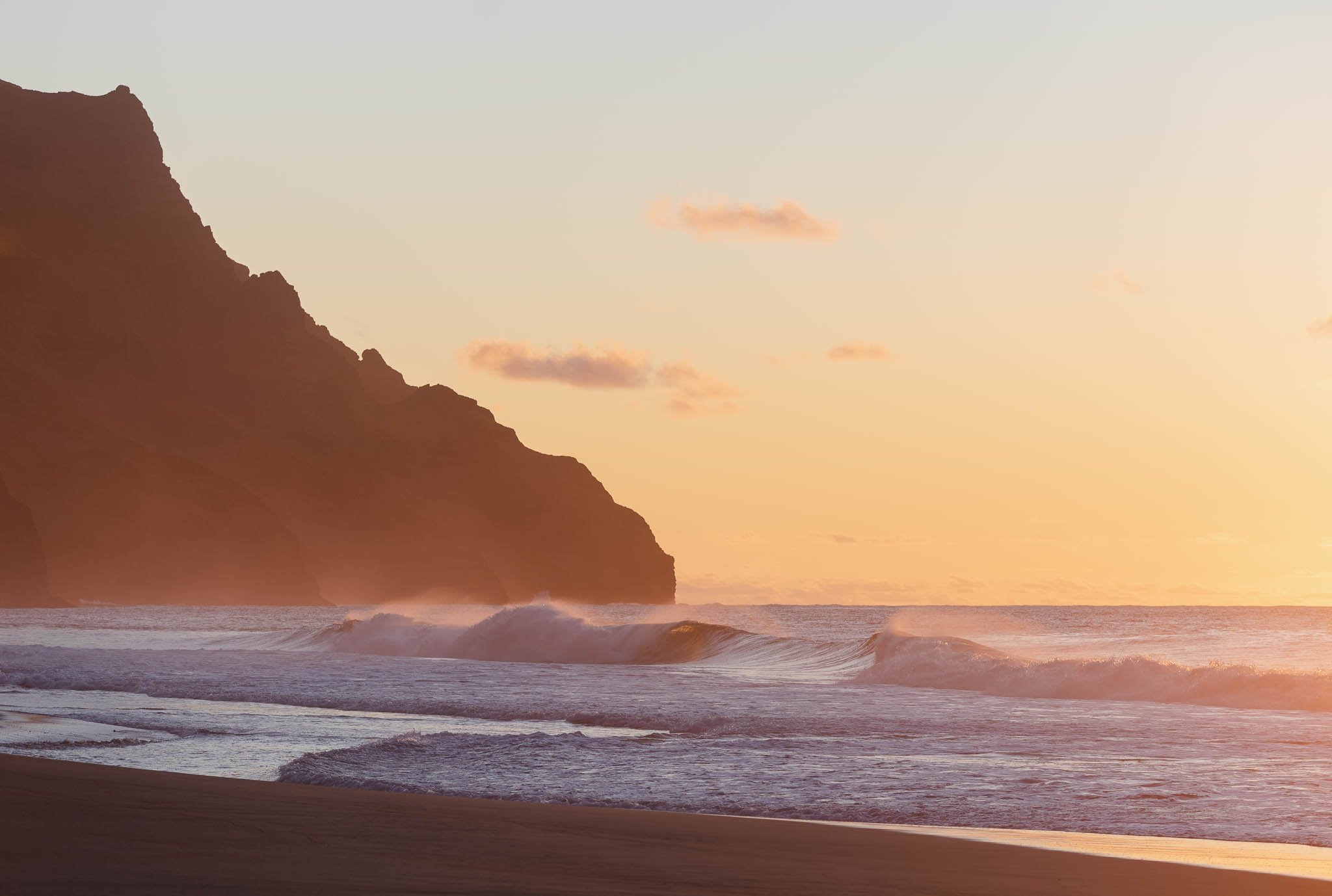

Trip at a Glance
| Distance | 22 miles |
| Elevation Gain | ~6,000 feet |
| Elevation Range | 0 feet - 818 feet |
| Length | 3 days |
| Permit | Kalalau Trail - Napali Coast State Wilderness Park |
| Highlights | Kalalau Beach, Kalalau Valley, Hanakoa Falls, Hanakapi’ai Falls |
| Type | Out-and-back |
| Trip Date | Mar 1 - 3, 2022 |
The Route
Trip Overview
The Kalalau trail hugs Kauai’s picturesque Napali Coast for 11 miles, winding through lush ridges and rainforests before arriving at the secluded, mile-long Kalalau Beach. This coastline, aptly named "Na Pali” meaning "the cliffs" in Hawaiian, is so rugged that it can only be explored by foot via the Kalalau trail, or seen from afar via a boat or helicopter.
The difficulty of the Kalalau trail cannot be conveyed by the elevation gain and mileage alone. The trail is barely a foot wide at its narrowest points, such as the infamous Crawler's Ledge at mile 7. The perilous dropoffs, perenially muddy ground, and overgrown corridors require careful footing.
Also, despite never exceeding 800 feet above sea level, there is still substantial elevation gain. The ups and downs are relentlessly steep and repetitive.
Morning light floods in through Kalalau Valley.
The rainy climate also makes this area prone to erosion, year-round mud, and flash floods, which has led to a number of fatalities over the years. Despite its reputation as one of the "most dangerous hikes in the world," Kalalau continues to attract visitors with its breathtaking beauty.
The Kalalau trail begins at Ke’e Beach. The only campsite along the way to Kalalau Beach is at Hanakoa at 6.5 miles in, which is small and has no views. Hence, most people hike the entire trail between Ke'e Beach and Kalalau Beach in one day, spending all the other days in between (just 1 day for us) at Kalalau Beach.
To see a mile-by-mile breakdown of the Kalalau trail as well as permits and packing tips, click on the button below to view my Kalalau trail guide. For my trip report, keep reading below.
Pre-Trip
In early 2022, I was talking with 2 friends about doing a girls trip in February. We wanted a snow-free destination, as well as something within the US because of unpredictable international travel restrictions due to COVID, and ultimately decided on Kauai. While I typically prefer alpine lakes and mountains to beaches and jungles, I couldn't shake the idea of backpacking the famous Kalalau trail. It was a bucket list adventure that I knew I had to experience while on the island.
Ocean views along the Kalalau Trail
I don't consider myself to have an extreme fear of heights, but I am still wary of sketchy, slippery trails where a single misstep could result in falling off a cliff. To prepare myself, I read blogs, watched YouTube videos, and perused recent trip reports. I feel more at ease when I am well-informed, and I reassured myself that if I encountered anything too unsettling, we could still cancel the trip.
We had 3 days in Kauai before our backpacking trip. The day we arrived, a trip report for 2 days earlier had just been posted to AllTrails, describing a segment after Crawler's Ledge near mile 8:
"…despite good hiking shoes and trekking poles I still felt that successfully crossing this segment was up to chance. In what I hope to never experience again, I saw my girlfriend’s foot slide on the loose rock before thankfully coming to a stop just shy of the edge...I have no doubt that falling at this spot would lead to death." - Louis on AllTrails
With this new review and the rainy weather forecast, we were not feeling optimistic about our trip.
Most of the Kalalau trail is narrow single-track with steep dropoffs.
Two days later, the day before our trip, there was another new AllTrails review:
"The 10 ft section mentioned by the last reviewer after crawlers ledge around mile 7/8 was in extremely poor condition. There was really no trail, just a sandy sloping grade to the ocean. Luckily, this section had some maintenance on 2/24 afternoon or 2/25 and on our return, there was a cut-in created."
There were no new photos, but I felt much better starting our trip with this as the latest update.
We had been procrastinating buying fuel canisters for our camp stoves, perhaps because of our uncertainty with doing the trip. We finally went to the Ace Hardware in Lihue the night before our trip. To our dismay, we learned they hadn’t stocked the fuel canisters for more than a month. The only other store they could suggest did not open until 7:30 AM the next morning, far later than we wanted to leave Lihue.
Our minds raced with possibilities: could we just rely on outbound hikers to give us their partially used canisters? Or should we try the ultralight way of cold-soaking? What better trip to forego hot food than in Kauai, where the lows would be in the mid 60s?
I thought I would try my luck posting in the Kalalau Facebook group for help, and fortunately, someone in the Facebook group offered extra unused canisters from their trip. It was another fantastic stroke of luck.
Day 1: Ke'e Beach Trailhead to Kalalau Beach
We left our hotel in Lihue at around 6:30 AM. We made stops on the way to pick up the fuel canisters from our Facebook benefactor, buy backpacking snacks, and eat Foodland poke for breakfast. When we arrived at Ke'e Beach, we had perfect Hawaiian weather of sunshine and blue skies. We were off to a rather late start, but we packed up and left the trailhead at 9:30 AM with high spirits.
The first 2 miles to Hanakapai'i Beach were wide and well-trafficked, but nevertheless muddy and steep, giving us a taste of the rest of the trail to come. After around 15 minutes of climbing, we peeked out of the trees for a bit to see a view overlooking Ke'e Beach from where we came. Ahead of us, the overlapping ridges of the Napali Coast extended endlessly into the distance.
The trail is wide in the first 2 miles, but nevertheless very muddy
Hanakapai'i Beach was lively with day hikers. For non-permit holders, this beach is the furthest you can hike on the Kalalau trail. To extend the day hike, some people hike up the valley following the Hanakapai'i stream to the towering Hanakapai'i Falls. This is a 2-mile detour one-way, so we wouldn't have time to check it out this time.
Hanakapai'i Beach
To continue on the Kalalau trail, we had to do our first stream crossing of the day. Hanakapai'i stream flows directly into the ocean, and is notorious for being uncrossable after storms. A not-so-fun fact is that stream crossings, not cliffs, account for the majority of deaths on the Kalalau trail. I pictured the wooden warning sign we had passed earlier, carved with an ongoing tally of the number of lives taken by ocean currents.
The stream was about thigh-high for 2 hikers fording it in front of us, but the water was slow-moving enough. As we stood contemplating the crossing, some other hikers mentioned that the stream was crossable on rocks downstream, right at the mouth of the stream where it meets the ocean. It was a little precarious, but we climbed our way over the boulders as whitewater swirled around us.
Hanakapai'i stream crossing
Crossing the stream with the ocean behind us
The crossing took us a while, so we only took a 15 minute snack break before continuing on the trail. The day-hiking crowds thinned out and the trail narrowed considerably once we were beyond Hanakapai'i Beach.
The next 4 miles were a blur; time flew but the trail dragged on. Our pace hovered at around 50 minutes per mile even though we took few breaks. Navigating the knotted, root-laced ground offered no respite for our tired ankles. Mud caked on to the bottom of our shoes in a thick layer and literally made our feet heavier.
In what I suppose you could call trail maintenance, some especially muddy sections of trail were strewn with dry tree parts.
Most of the time we hiked in the shade of the dense forest, which made the 80 degree temperatures tolerable. When we occasionally broke out of the trees, the view of the Napali coast barely changed. It's easy for this trail to be demoralizing when you only think about the destination, which easily outshines much of the journey. But we tried to celebrate the mini-highlights of this section that were a break from the monotony: scampering goats, babbling streams, and brief glimpses of ridges.
Hanakoa Falls is visible in the center of the photo. The threadlike waterfall is nestled in a rippled mountainside.
Hanakoa stream
We got lost around mile 4, which set us behind even further. Kalalau is the only maintained trail in the park and very heavily trafficked, so we didn't think following it would be a problem. But the trail gets ambiguous around streams because hikers create new paths while looking for the best place to cross the stream, take breaks, or filter water. We hiked for over 10 minutes off the trail before we noticed it was getting hard to tell where to go next. The map showed that we were only around 50 feet downhill from the actual trail, so we tried to bushwhack our way up. With nothing to hold on to, and the brush-covered ground crumbling beneath our feet with each step, we made little progress. It got too sketchy and we ultimately had to backtrack.
Hanakoa camp was at mile 6.5. A sign marked the beginning of the half-mile offshoot to Hanakoa Falls. There were a few tents and a large stream. Not much was notable about this checkpoint except the fact that I couldn’t believe we were only barely halfway. I envied the people who got to set down their gear here and set up camp, but this thought lasted for maybe 2 minutes until we heard the dreaded buzzing of mosquitoes and we got out of there as fast as we could.
Sightseeing helicopters are a common sight on the Kalalau trail. From far away the helicopter looks like a flying insect.
My anticipation grew as we got closer to Crawler's Ledge. The section right before Crawler's Ledge zig-zags on a steep grade down to the level where Crawler's Ledge starts. While not as vertigo-inducing as Crawler's Ledge, the crumbly, dry dirt was a slippery nightmare. Hiking sticks helped immensely by giving me 2 more points of contact with the ground in case a foot slipped.
People have drastically varying accounts of their experiences with Crawler's Ledge, from death-defying to anticlimactic. I thought it was exhilarating. I kept my eyes glued to my feet while I walked, but I could see the sheer dropoff and the sparkling blue ocean in my peripheral vision. Despite the narrowness, the ledge section is rocky so the footing is solid. I pressed my inside hand against the wall to keep my center of gravity away from the cliff edge. We were only 200 feet above sea level at this point, and we were one short leap away from the churning waves below. The sound was thunderous.
Hiking sticks helped a lot on the section before Crawler’s Ledge.
The trail looked impossibly skinny as we approached.
Crawler’s Ledge continues around the bend, but it looks like it just disappears off the cliff.
Standing on Crawler’s Ledge. It’s much more manageable than it looks from far away.
After Crawler's Ledge, the trail spent more time in the open and the ocean views became more consistent. We breezed past the section at mile 8 thanks to the trail maintenance that had occurred just days before our trip. When we made it to the Red Hill, the last descent to Kalalau Beach, we caught our first glimpse of our destination.
This is the section at mile 8 that had just received trail maintenance. You can see how precipitous it would be without the cut-in due to the angle of the slope.
The setting sun made Kalalau Beach glow
Descending Red Hill
We had to cross Kalalau Stream before reaching Kalalau Beach. We wasted some time looking for a place to cross, but the sunset light was even weaker in the forest and it was getting dark quickly. We gave up and took our shoes off to ford it.
I was overwhelmed with feelings of bliss and relief when we finally arrived at a clearing and the expansive Kalalau Beach emerged on our right. We had been hiking for the past 9.5 hours with little breaks, and I was thoroughly physically and mentally drained.
I've been to countless Hawaiian beaches, but even the most picturesque of beaches are interrupted by sights of the resorts or homes built right next to them, or flooded with people. Kalalau however, is flanked only by the beautiful ridges of Kalalau Valley. The beach was wide, pristine, and completely empty.
Kalalau Beach at sunset
The entire beach is lined with forest. The campsites are tucked away in the trees, which provide welcome shade from the intense daytime sun. Most sites have a great view, and all of them are just steps from the beach. A composting toilet is located at around the midpoint of the beach. At the end of the beach is a waterfall that is also the water source for most campers.
We were worried that there'd be few spots to choose from since we were arriving so late in the day, but there were very few campers for at least the first half mile of the beach. Even after that, everyone was still very spread out. We picked a spacious site close to the waterfall and set up our 2 tents in the post-sunset glow.
I rarely camp outside alpine environments, so the mid-60s night temperatures were wonderfully warm. In contrast with the usual down puffy, I only brought a mid-weight fleece. I correctly anticipated being very sticky all day because of the tropical humidity, and I was glad I had a sleeping bag liner instead of my usual 20-degree sleeping bag.
It was easy to fall asleep to the roar of the waves, which drowned out all other sound. I did wake up a little cold in the middle of the night. Besides my fleece, I had no more layers to put on, so I took my emergency blanket out of its package for the first time ever and laid it over my sleeping bag liner. It felt ironic using an emergency blanket in 60+ degree temperatures, but it helped a lot.
Day 2: Beach Day at Kalalau Beach
Waking up without an alarm at Kalalau Beach was the epitome of paradise. I rarely have rest days while backpacking. There is a new destination every day, and each morning is a familiar, but hurried routine of eating and packing up.
This morning, on the other hand, was as leisurely as could be. Our only plan was to enjoy Kalalau Beach. If we had more days to spare, we would've definitely considered other activities. My research before the trip had revealed some swimming holes tucked away in Kalalau Valley like Big Pool that require off-trail hiking to get to. Beach caves are also accessible in the summer when the waves recede.
I thought I would get a lot of reading done, but after rolling out of my tent around 8 AM and making oatmeal, I sat on the beach and the hours flew by. Watching wave after wave rise and crash was hypnotic; I barely took photos or went on my phone.
Helicopters buzzed around overhead, and the occasional sightseeing boat floated by. Despite the glimpses of technology that diminished the feeling of wilderness, I took satisfaction in the fact that others could only look at the beach from afar, while we could experience the beach firsthand.
The campsite we chose was very close to the base of the waterfall in this photo.
The ferocious waves were haloed by their own spray. I didn’t feel comfortable wading even this deep in the water.
After a few hours in the glaring sun, we went back to our shaded campsite. I napped on-and-off, read, snacked, and watched goats amble through the campground. Soon it was 4 PM, which was the time that we had agreed upon to go for a walk.
We walked around a mile through the campground to Kalalau Stream, which we crossed right before arriving at Kalalau Beach the day before. Kalalau Stream is not really a destination in itself, but I wanted to take a dip in some kind of water since I didn’t dare enter the ocean. The water was refreshing and very cold.
Taking a dip in Kalalau Stream where the trail crosses over to Kalalau Beach.
As we were walking back, we noticed a rock in the middle of the beach. It looked out of place since all the other rocks lined the edge of the beach while this one was alone in the center. I wondered if it could be a monk seal, but I immediately doubted myself. Monk seals are an endangered seal species found in Hawaii that come on to beaches to sunbathe, and sightings are relatively rare.
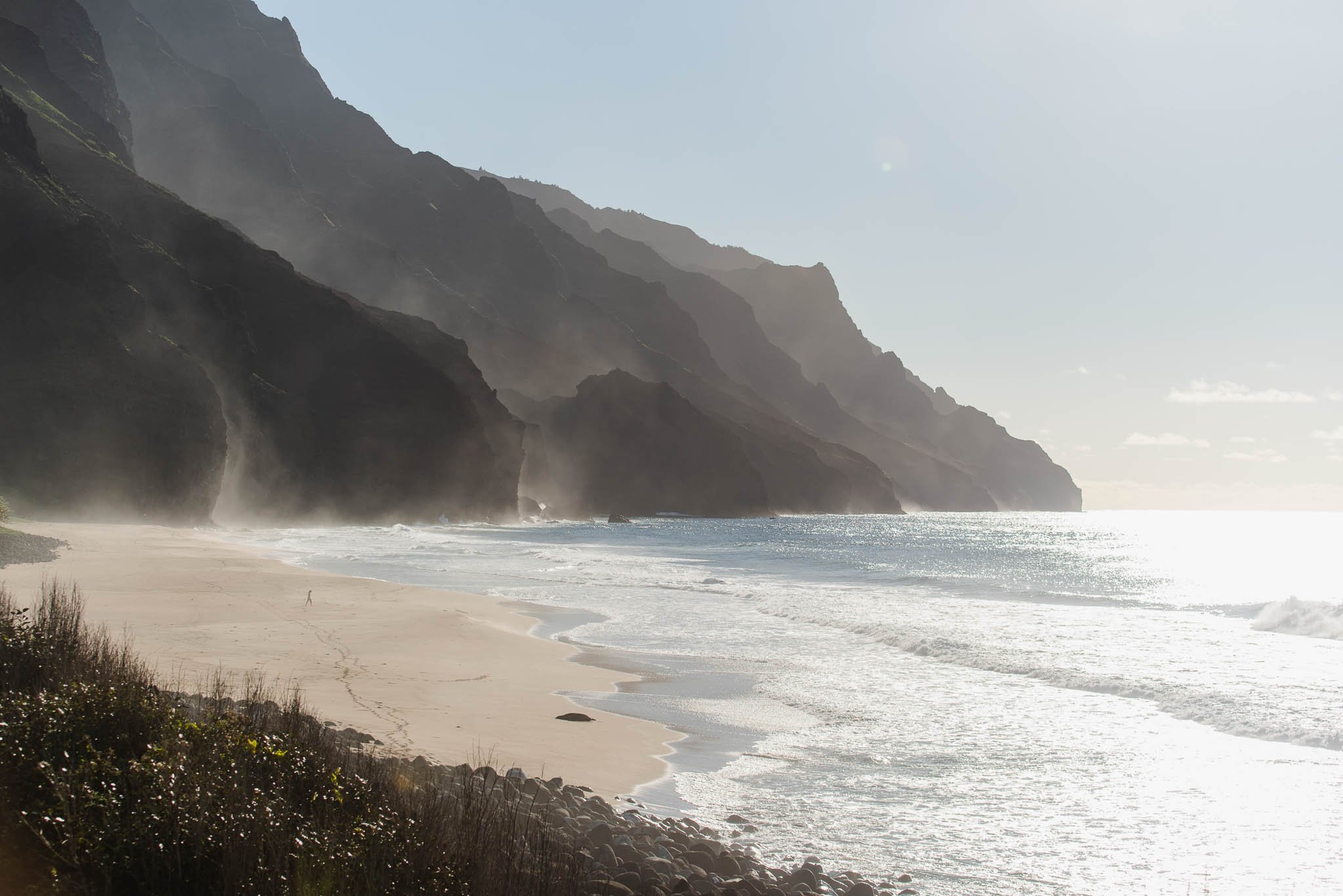
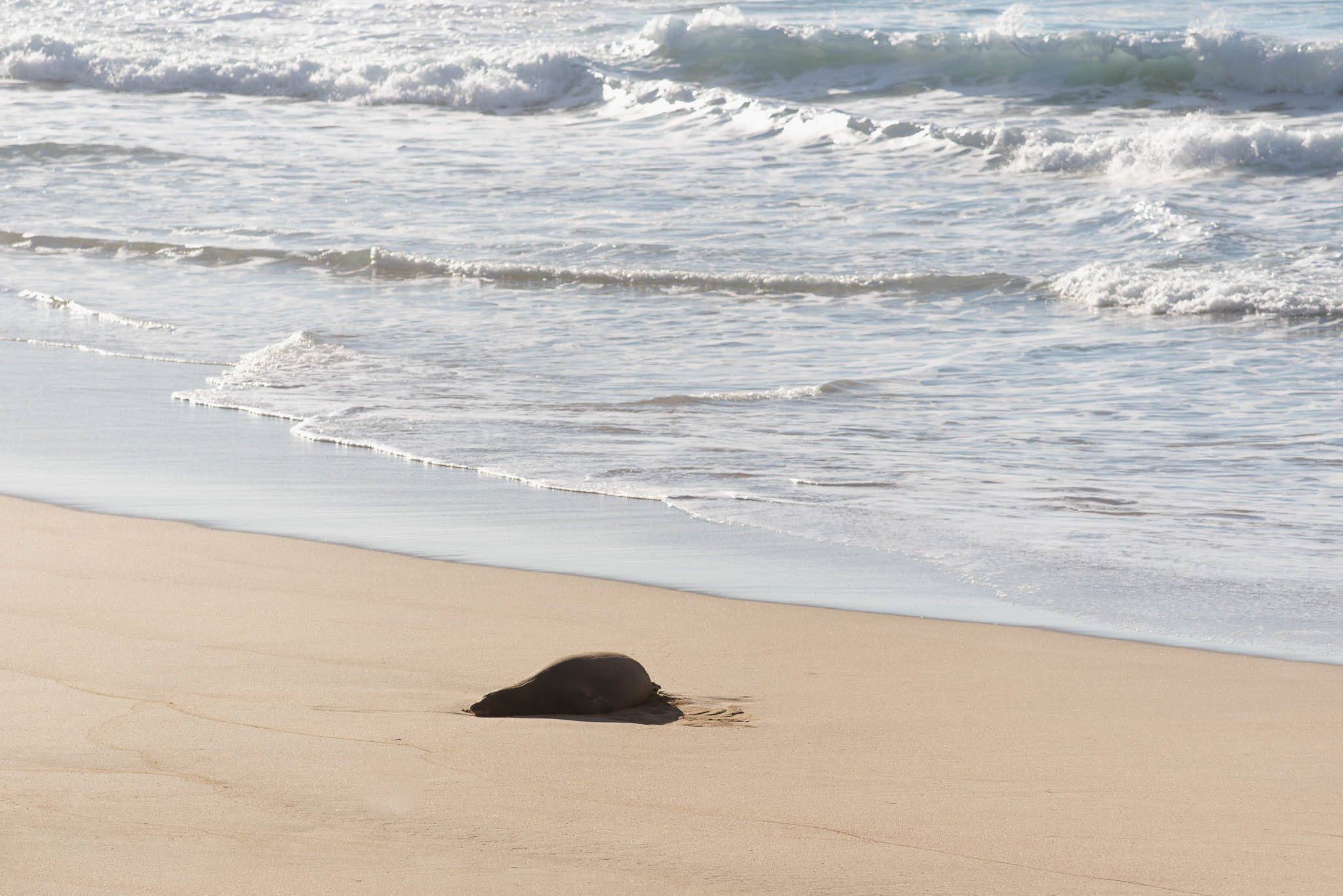
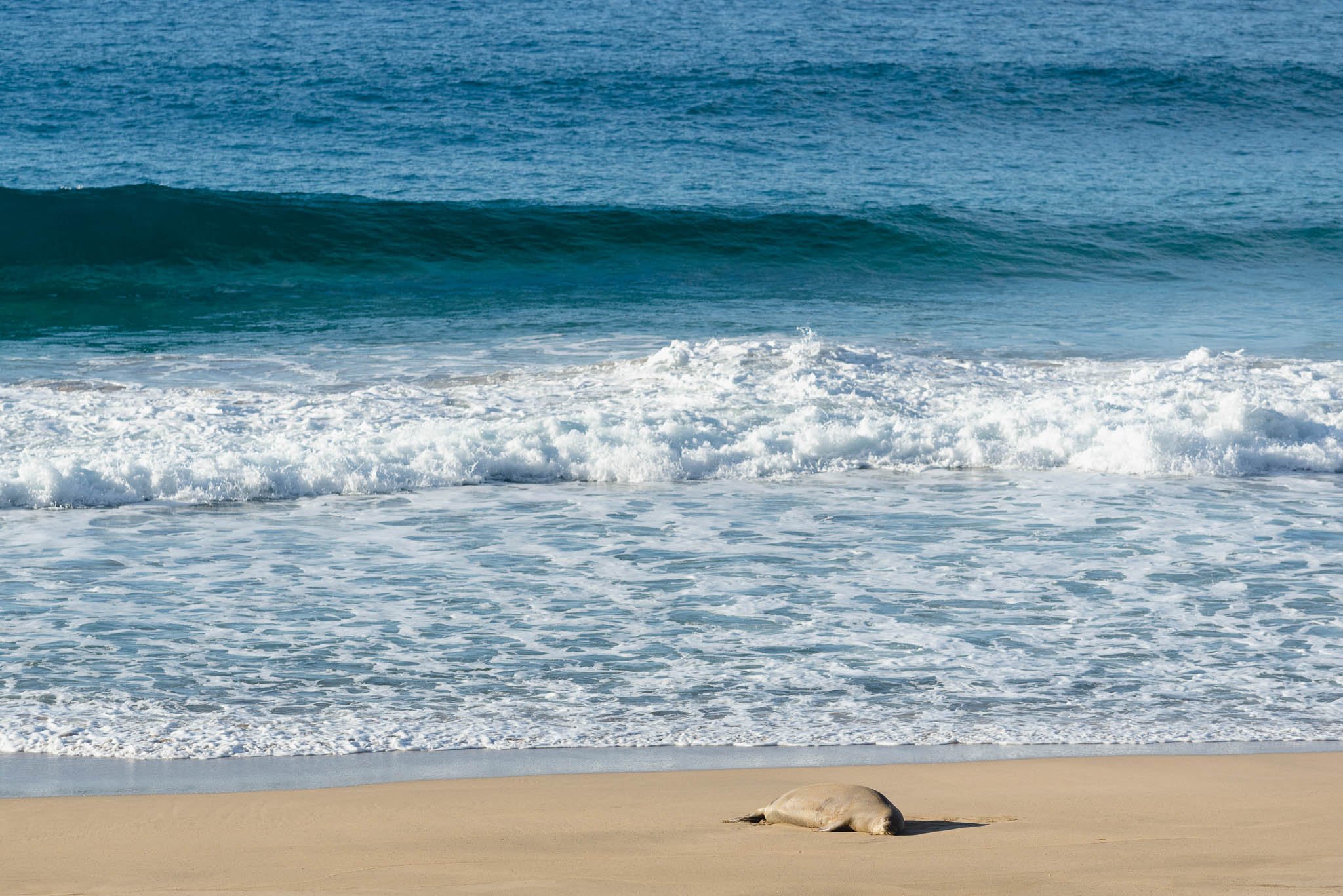
As we walked closer, the shape of a head and flippers emerged from the slender, oblong shape, and I excitedly realized it was not just a rock. At that moment, I was very grateful for having lugged my telephoto lens to Kalalau Beach so that I could capture photos of the seal from a safe distance.
I stayed by the seal for over an hour until the sun completely set. Wildlife sightings while backpacking are such highlights, and even then, they are usually fleeting as most animals bolt at the slightest detection of humans. The monk seal, however, basked in the sun peacefully, not even acknowledging my presence.
For a creature that barely moved, the seal was mesmerizing. I didn't take my eyes off of it for fear that I would miss the rare movement: blinking eyes, a lift of its tail, or even a repositioning of its head. At one point, the seal suddenly sneezed, or did something akin to a sneeze. Its body seized up and jiggled as it snorted air. Then it raised its head and looked around, as if to check if anybody had seen. It was so adorable.
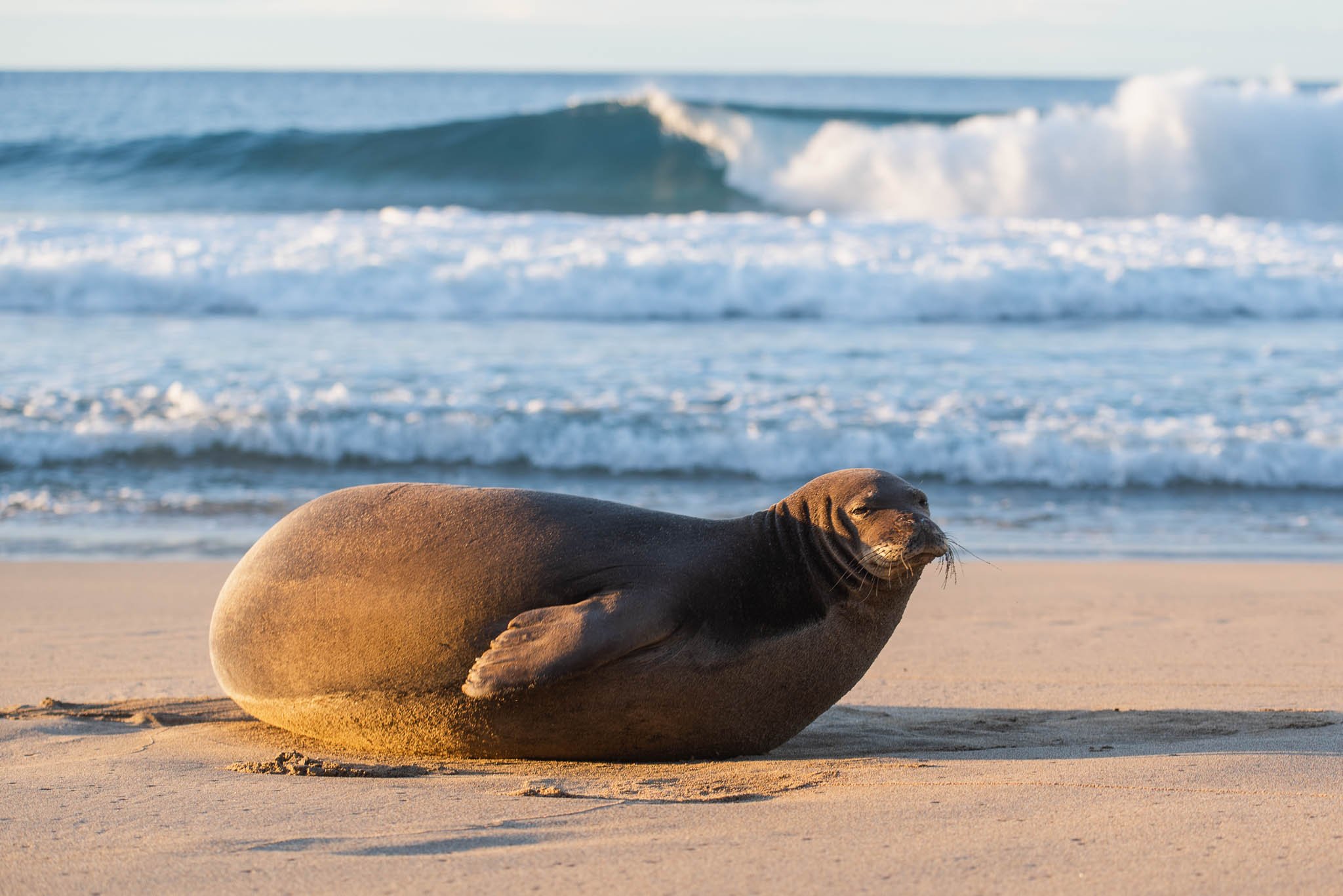
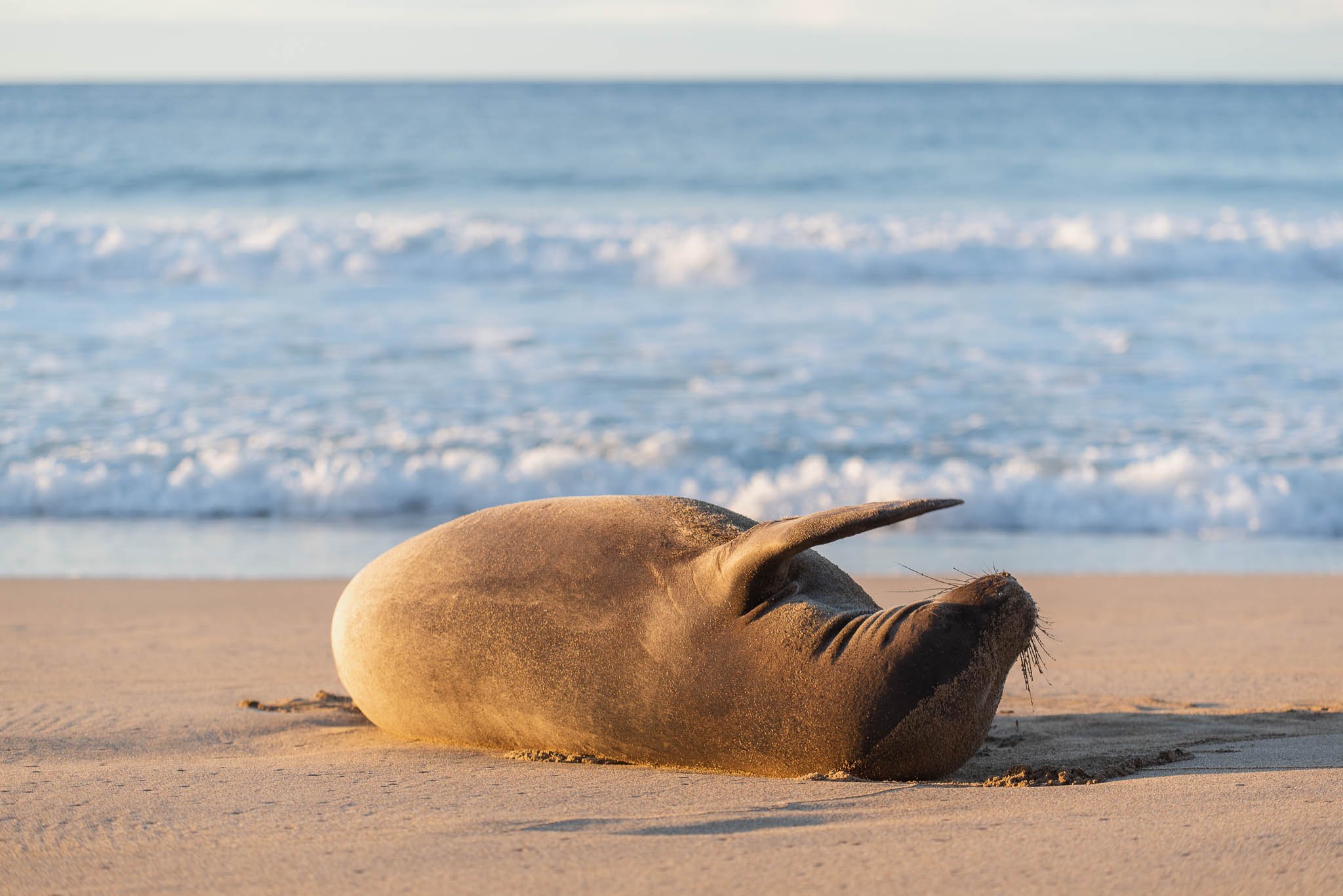
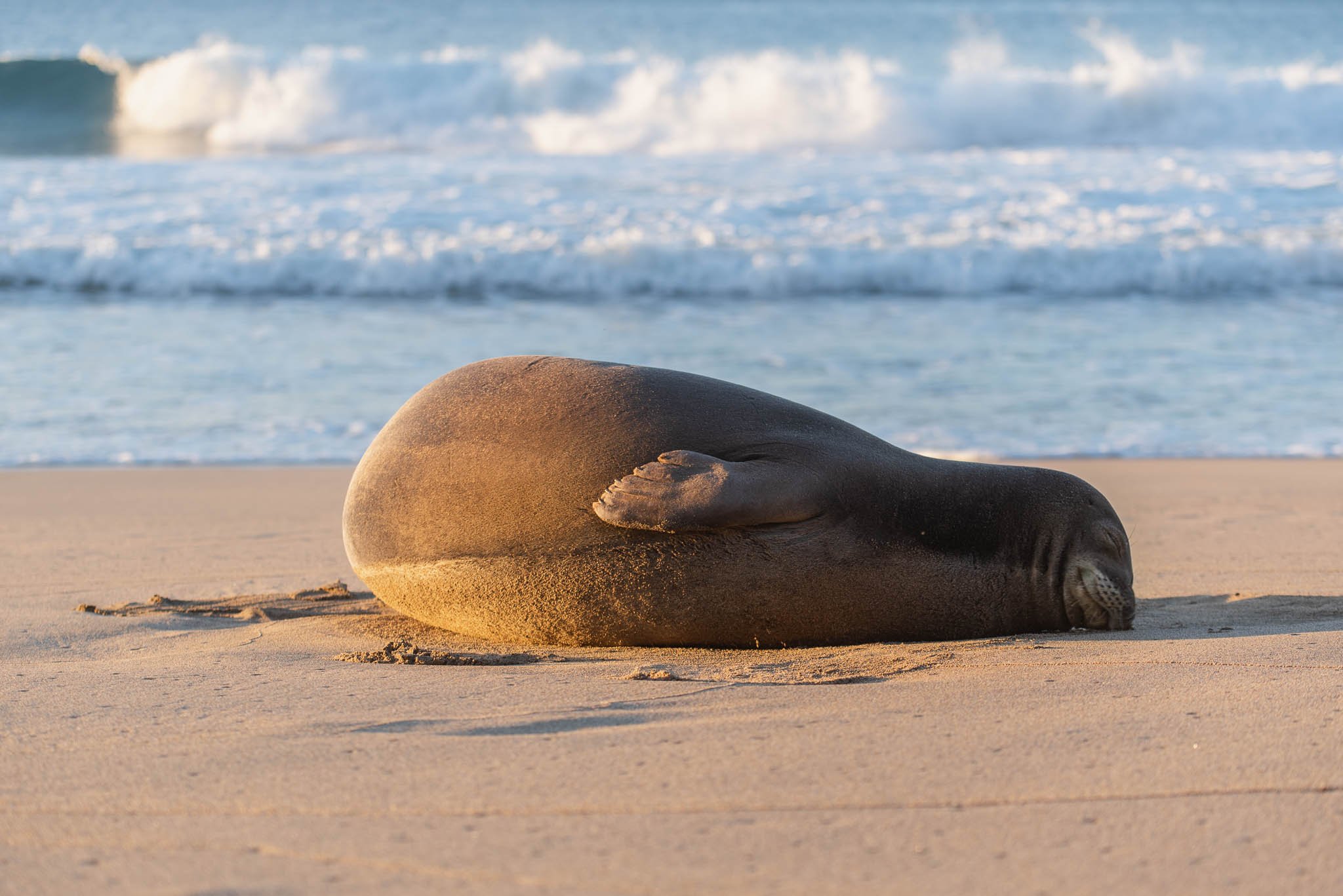
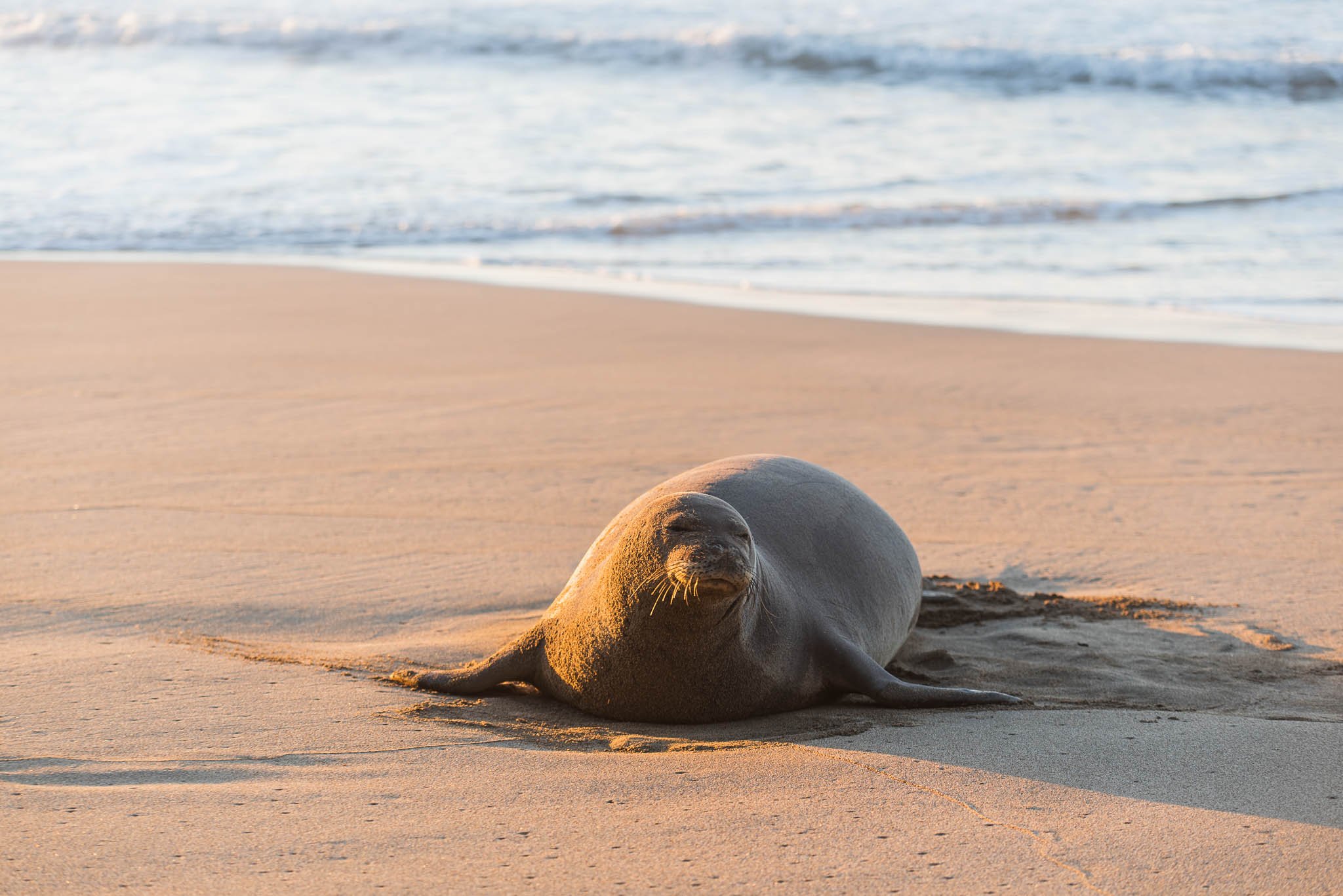
The pounding waves created a veil of sea spray that surrounded the cliffs at the far end of the beach. It was a beautiful scene with the layers of silhouettes.
The backdrop of Kalalau Beach
Beach sunsets are especially colorful. The ocean and wet sand create an extra large canvas for the sun to paint its saturated oranges and reds. When the light started fading, we finally started walking back towards our campsite. The whole time, the seal had not moved from its spot. Seeing the seal was the highlight of our trip, and it felt like a unique and exclusive experience. I don't think the campers on the far end of the beach had even noticed the seal.
Day 3: Kalalau Beach to trailhead + Hanakoa Falls side trip
We started the next day before sunrise. It had rained overnight unexpectedly, so the gear that I hung out to dry was now wet, along with our tents. The tropical humidity only added to the dampness. We packed up slowly, trying to put off stuffing soggy tents into our packs.
We finally left camp at 8 AM. When the trees cleared at the end of the campgrounds, we turned to take one last look at Kalalau Beach. Surprisingly, the seal was still on the beach. It seemed like it was in the exact spot that we saw it the day before.
The morning air was refreshing as we hiked since the sun was mostly blocked by the mountains. The hike back was a lot faster. We knew which crossings we needed to take our shoes off for, and we were diligent about checking navigation and didn’t stray off trail.
Last look at Kalalau Beach from Red Hill
These wrinkly ridges are so recognizably Hawaiian.
I love the cool tones the forest takes on in indirect light.
We were doing fine on time when we got to Hanakoa, so we added in the Hanakoa Falls side-trip. It was only half a mile one-way, but the trail was very overgrown. The waterfall is not impressive in its volume, but rather its height. You have to crane your head back to see all of it—at least, the part that can be seen from the bottom. Aerial photos show that the waterfall is even taller than what is visible from its base. The higher tiers of the waterfall are nestled in the valleys of the ridges. At the bottom of the waterfall is a dark green pool. The plant-carpeted walls surrounded us on all sides and shaded us even at midday.
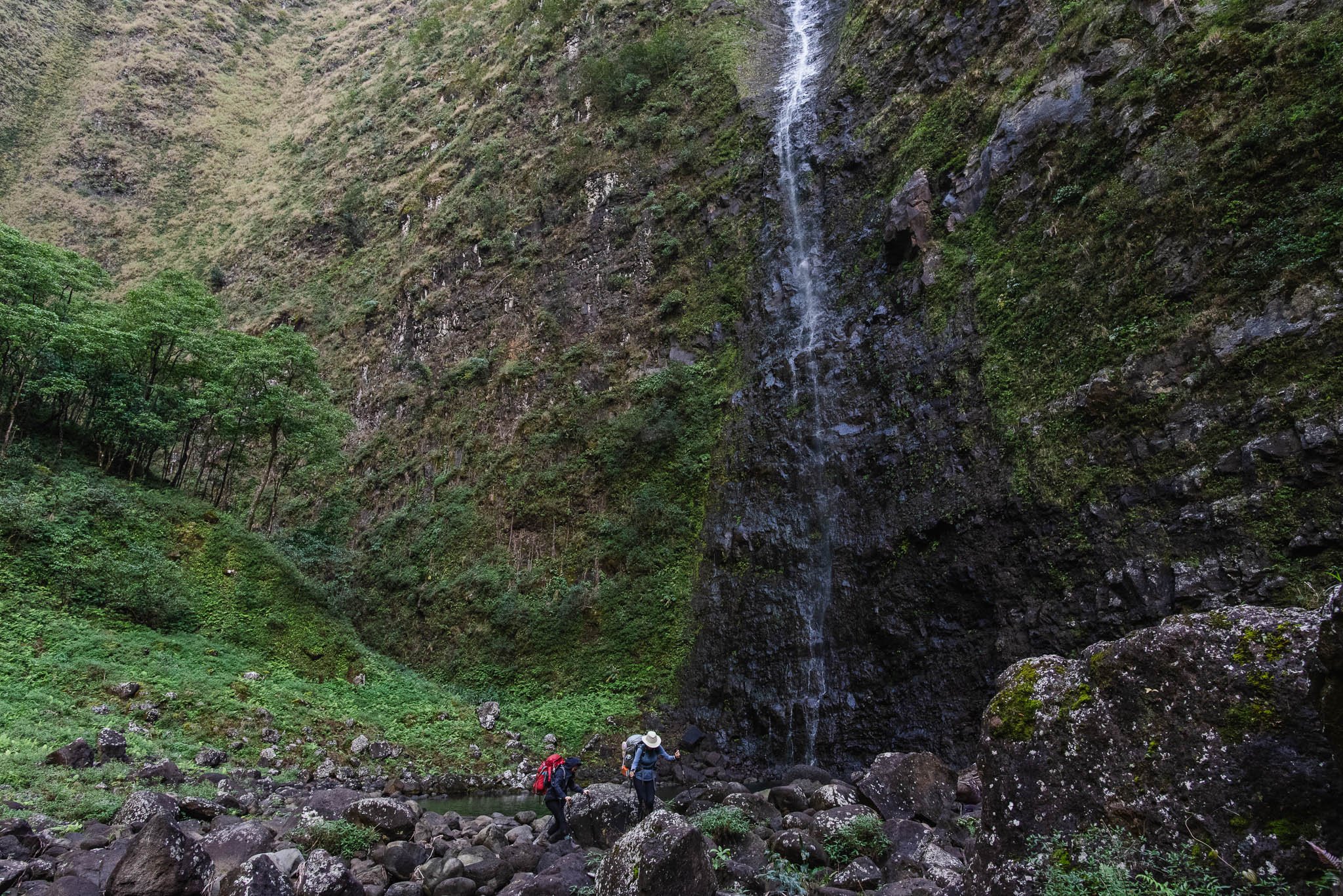
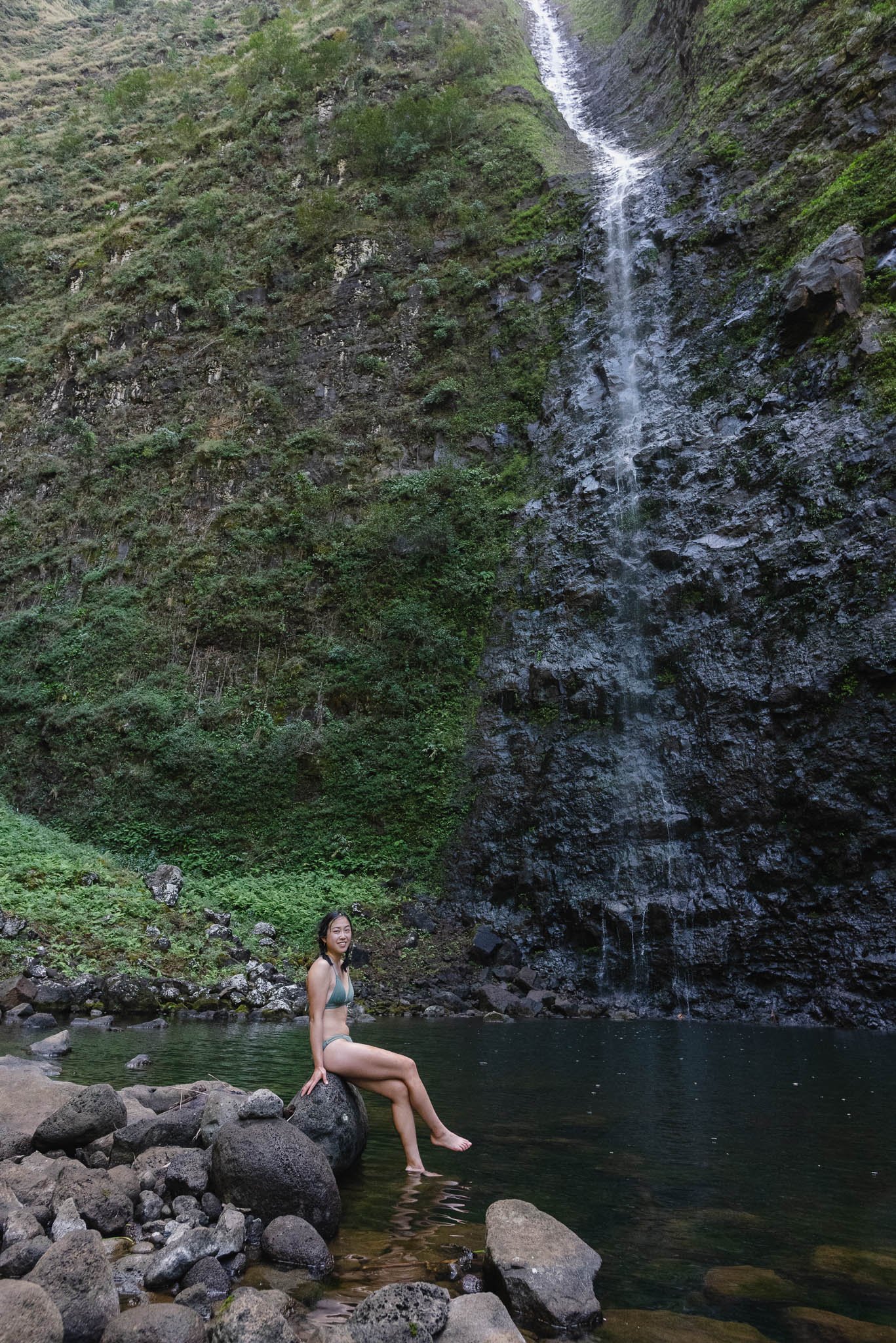
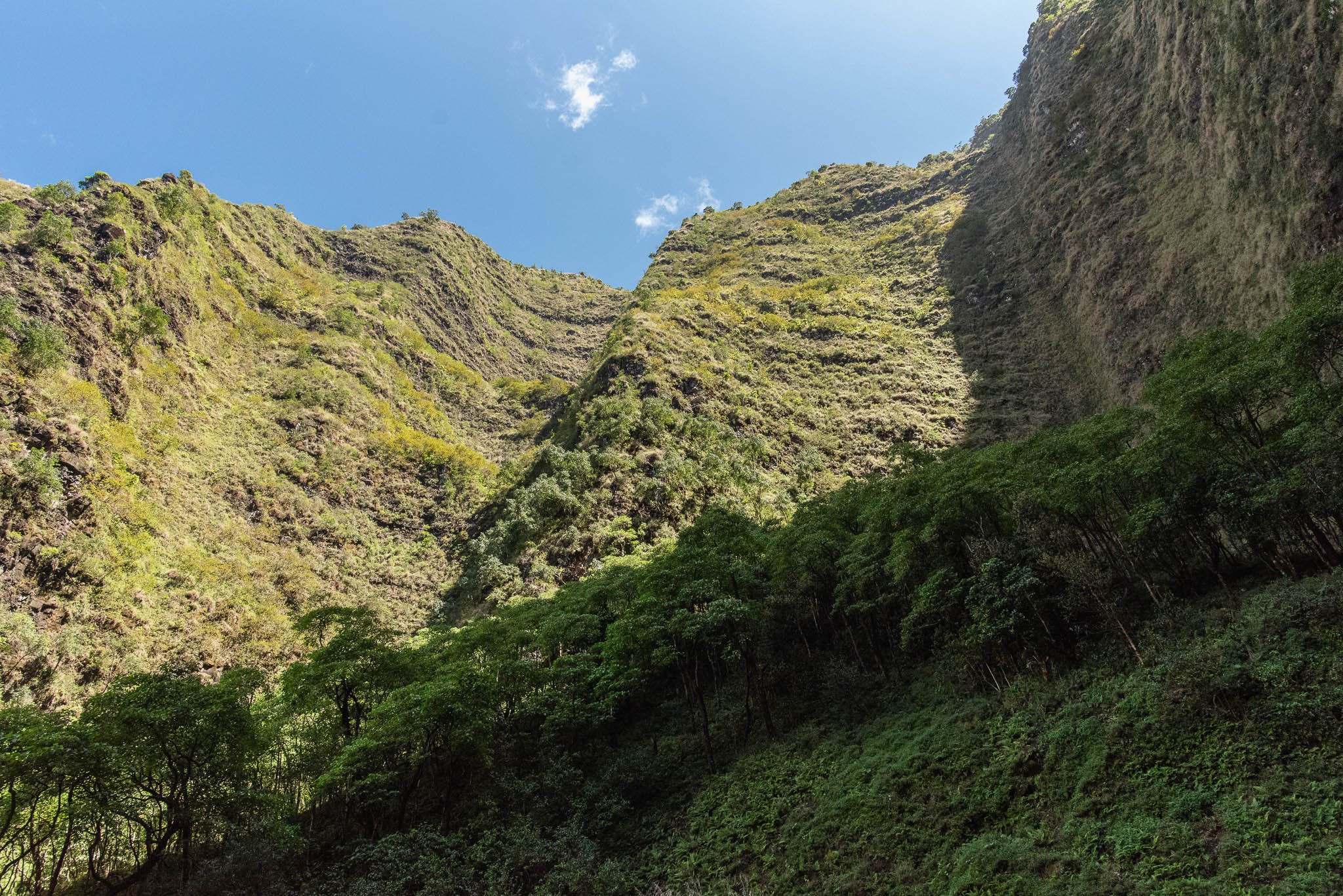
After a lunch break at Hanakoa Falls, we made our way back to the junction and continued on the Kalalau trail. Since the trail started at a beach and ended at another beach, we had just as much elevation gain to get through on the third day as we did on the first.
We walked past the trailhead sign minutes before 6 PM, sticky with layers of sweat and sunblock, legs and knees aching, but otherwise unscathed. Our elapsed time for this day was 10 hours including the Hanakoa detour, which put us at about 1 hour faster than day 1. We used the beach showers to rinse off our musty feet and then walked the short distance back to the parking lot.
The variety and density of the flora was astounding.
I feel so lucky that we were able to complete the trip safely and in perfect weather. Even though Kauai has a plethora of gorgeous beaches that you can drive up to, there is something special about choosing to hike the grueling 11 miles to Kalalau Beach. Between lounging on the beach, walking under the impressive ridges of the Napali Coast, and falling asleep to the sound of the ocean, I think it was definitely worth it.




